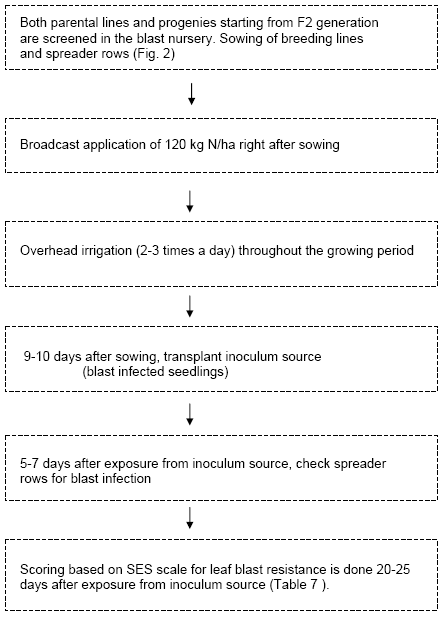
Stress and disease tolerance
Breeding for disease resistance in rice: Blast
.gif)
Approaches to evaluate resistance to bacterial blast
Identify sources of resistance for this disease
Evaluate breeding lines for resistance to this disease
Resistance genes tagged and available for marker-aided selection applications
Rationale
Breeding for disease resistance aims to incorporate durable resistance into improved rice varieties. Many resistance sources are available from IRRI’s vast collection of rice germplasm from which new varieties are developed. However, varieties released as resistant became susceptible after only few seasons or few years of cultivation due to pathogen evolution and adaptation to cultivated varieties. Thus, breeding for disease resistance is a continuous challenge to rice breeders and pathologists.
What is blast?
Blast is among the most widespread and damaging diseases of rice in upland and rainfed areas causing more than 50% losses in yield.
The disease has two commonly recognized phases: leaf blast seedling and neck blast. The pathogen causing blast Magnaporthe grisea, consisted of 18 lineages in the Philippines. In IRRI blast nursery, 4 lineages exist while 9 lineages are present in another upland site in Cavinti, Laguna.

Blast attacks at different locations on the rice crop
Are there any blast resistant genes?
Several major genes for blast resistance have been identified and near-isogenic lines with ‘indica’ (CO39) and ‘japonica’ (Lijiangxintuanheigu) background are now available. Table 5 shows the blast reaction of some NILs to five virulent blast isolates.
Table 5. Reaction of NILs with ‘indica’ and ‘japonica’ background to virulent blast isolates

Recently, Dr. Y. Fukuta and his colleagues have also developed a new set of monogenic lines for blast resistance in two backgrounds (LTH and CO39). The LTH lines are available to NARES through collaborations. The CO39 lines are also available since 2004.
Breeding Strategy
Breeders and pathologists work together to screen and breed for resistance to blast, along with other desired traits for various ecosystems. Elite lines and rice germplasm serving as donors for specific traits are used as parents in hybridization program. Ideally, donors showing partial resistance for blast are preferred. F1 seeds are increased to produce F2s. Starting from F2s, breeders and pathologists evaluate the lines for blast resistance. Thus, selection begins at F2 generation, and continued from F3 to F6 or F7 generation, along with other desired agronomic traits.
Identification, Evaluation and Selection for Resistance to Leaf Blast
Screening for resistance to leaf blast is usually done in the blast nursery at IRRI where natural blast infection is highly favorable. As blast populations are very diverse, it is important that the varieties be evaluated to an unlimited range of pathogen populations. To maintain the pathogen population (natural source of inoculum) in the blast nursery, 8-10 rice varieties with different level of susceptibility to blast are continuously planted in the site (Table 6).
Table 6. Reaction of rice varieties used as inoculum source (spreaders) to existing lineages of blast isolates in the blast nursery.

Since the durability of single resistance genes to blast is very limited, efforts in the development of resistant varieties are geared towards race-non-specific or partial resistance. The screening method done under natural blast nursery condition is shown in the scheme below.
Screening Method: The different steps of natural infection


Fig. 2. Layout of breeding lines and spreader rows at IRRI Blast Nursery to screen for blast resistance.
Evaluation for blast resistance
Evaluation for blast resistance is done at 20-25 days after exposure from inoculum source available at the blast nursery. Breeding lines with scores of 4 to 5 are also selected for partial resistance. Timing of rating is important.
Table 7. Scoring system for blast resistance

Blast R-Genes Tagged with Molecular Markers
Three major R genes effective against many blast races in several Asian countries have been tagged with markers linked to the gene. These markers are currently being used in rice improvement program by NARES from India, Indonesia, Vietnam and Thailand (Table 8).
Table 8. Molecular markers used in MAS to improve resistance to blast.

a Encodes a NBS-LRR protein and is a member of a multigene family in rice.
Case studies: Advanced backcross or gene pyramiding coupled with marker-aided selection
Advanced backross QTL approach
Using the advanced backcross QTL approach, RIFCB at Indonesia is incorporating quantitative blast resistance to their popular upland variety. Resistant donor Oryzica Llanos 5 was crossed to Way Rarem, a popular rice variety for the upland area in Indonesia. The backcross lines (BC2F3) are being analyzed for association between candidate defense genes and blast resistance. Selections are being carried out based on partial resistance to blast at disease hotspots. Genotyping for candidate defense genes conferring partial resistance will be carried out at advanced stages.
Gene pyramiding of major genes
Two blast major genes Pi-1 and Pi-2 were used for developing breeding lines using MAS through ARBN collaboration. For example, RIFCB incorporated Pi-1 and Pi-2 in three local varieties, Way Rarem, Cabacu, and Jambu through double crosses. Lines were selected at F4 generation with desirable agronomic characteristics such as plant height, maturity, tiller per hill, yield and resistance to leaf and neck blast and aluminum toxicity. MAS for Pi-1 and Pi-2 was performed at advanced generations. The resistant lines were evaluated in Indonesia and at IRRI through shuttle research.
CRRI introduced genes with multiple blast resistance into popular variety Kalinga III, resulting in backcross lines carrying blast resistance genes Pi2(t) and Pi9(t) and a new gene derived from wild rice O. minuta.
DOA applied MAS to incorporate bacterial blight and blast resistance genes into high-quality Thai rice varieties for export (KDML 105, RD6, Khao Jao Hawn Suphanburi, and HTA 88060-5B-3). Using molecular markers, advanced lines carrying genes Pi2, xa5, xa13, and Xa21 with good performance and agronomic characteristics were selected and tested in farmers’ fields.
Click here to see the references used in this lesson.
Next lesson
The last lesson in this module is also about a disease. This time we will focus on bacterial blight.
